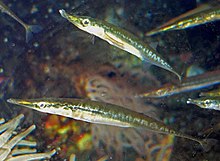
Pholidae is a family of marine ray-finned fishes, known as gunnels, in the scorpaeniform suborder Zoarcoidei. These are fishes of the littoral zone and are mainly found in North Pacific Ocean, with two species found in the North Atlantic Ocean and Arctic Ocean.

The painted greenling is a species of marine ray-finned fish belonging to the family Zaniolepididae, which includes this species and the combfishes. It is endemic to the northeast Pacific Ocean. It is the only species in the genus Oxylebius.

The treefish is a species of marine ray-finned fish belonging to the subfamily Sebastinae, the rockfishes, part of the family Scorpaenidae. It is native to the eastern Pacific Ocean.

Rhinopias is a genus of marine ray-finned fish belonging to the family Scorpaenidae, the scorpionfishes. The species in this genus are found in the Indian and Pacific oceans.

The brook stickleback is a small freshwater fish that is distributed across the US and Canada. It grows to a length of about 2 inches. It occupies the northern part of the eastern United States, as well as the southern half of Canada. Small populations are scattered throughout the Mississippi-Great Lakes basin extending to Colorado, New Mexico, Kentucky, Tennessee, etc., though some of these areas are not native to the species. This small fish inhabits clear, cool streams and lakes. They eat small invertebrates, algae, insect larvae, and occasionally their own eggs. They are also preyed upon by smallmouth bass and northern pike. Feedin time is usually dawn and sunset. The brook stickleback does have active competition mostly from minnows, but feeding times are different, along with diet. Spawning occurs in midsummer. Males secure a territory, build a nest, and mate with females. Males provide protection for the eggs, ward off predators, and usually die later in the season. This is considered an annual species. The nests are built out of aquatic grasses. Though the brook stickleback is not considered a threatened species, deforesting and changing waters are altering ecosystems of the species. Harvesting of trees around riparian environments is having a large effect of the stream ecosystem where the brook stickleback resides.

The Norway bullhead is a species of marine ray-finned fish belonging to the family Cottidae, the typical sculpins. This species is found in the northeastern Atlantic Ocean.
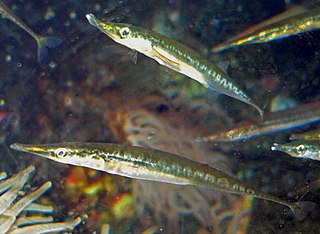
Aulorhynchidae, the tube-snouts, is a small family of marine ray-finned fishes belonging to the suborder Gasterosteoidei in the order Scorpaeniformes. These fishes are found in the northern Pacific Ocean.
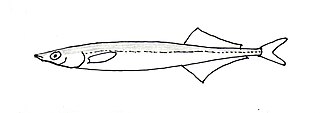
The Korean sandlance is a species of marine ray-finned fish belonging to the family Hypoptychidae. The Korean sandlance is the only species in this monotypic family and genus and is found in the northwestern Pacific Ocean.

The penpoint gunnel is a species of marine ray-finned fish belonging to the family Pholidae, the gunnels. This fish occurs in the eastern North Pacific Ocean.

Bellator egretta, the streamer searobin, is a species of marine ray-finned fish belonging to the family Triglidae, the sea robins. This fish is found in the western Atlantic Ocean.
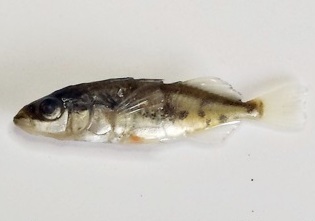
The blackspotted stickleback is species of ray-finned fish belonging to the family Gasterosteidae, the sticklebacks. This fish is found in the western Atlantic from the coasts of Newfoundland (Canada) to Massachusetts. This is a benthopelagic species of marine and brackish waters, rarely entering freshwater, which remains near the shore. It is frequently associated with floating vegetation. The male builds a nest, in which the females deposit eggs and the male guards and aerates them. It is a small fish which reaches a maximum published total length of 7.6 cm (3.0 in), although 3.5 cm (1.4 in) is more typical. The specific name honors Richard H. Wheatland who was the Cabinet Keeper, for the Essex County Natural History Society of Salem, Massachusetts and who collected type of this species in 1859.

Agonus is a monospecific genus of ray-finned fish belonging to the subfamily Agoninae in the family Agonidae. Its only species is Agonus cataphractus, commonly known as the hooknose, pogge or armed bullhead. This is a demersal fish found in the coastal waters of the northeastern Atlantic Ocean.
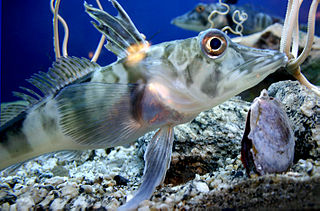
Chionodraco hamatus is a species of marine ray-finned fish belonging to the family Channichthyidae, the crocodile icefishes. It is found in the Southern Ocean.

Liparis liparis, the common seasnail, striped seasnail or seasnail, is a small species of marine ray-finned fish belonging to the family Liparidae, the snailfishes, in the order Scorpaeniformes, the scorpionfishes and flatheads. It is found in the northeastern Atlantic Ocean where it lives on the seabed.

The Weedsucker is a species of clingfish found along the coasts of Namibia and South Africa, from Lüderitz to the mouth of the Kei River. This species grows to a maximum length of 3.5 centimetres (1.4 in) Total Length. This species is the only known member of its genus and was described by James L.B. Smith in 1943 with the type locality being described as 10 miles (16 km) west of East London, east of Igoda, South Africa.

Sebastes diploproa, the splitnose rockfish, is a species of marine ray-finned fish belonging to the subfamily Sebastinae, the rockfishes, part of the family Scorpaenidae. It is found in the northeastern Pacific Ocean.

Sebastes rastrelliger, the grass rockfish, is a species of marine ray-finned fish belonging to the subfamily Sebastinae, the rockfishes, part of the family Scorpaenidae. It is native to the waters of the eastern Pacific Ocean.

The large-scaled gurnard is a species of marine, demersal ray-finned fish from the family Triglidae, the gurnards and sea robins. It is found in the eastern Atlantic Ocean and the Mediterranean Sea.
The radiated shanny is a species of marine ray-finned fish belonging to the family Stichaeidae, the pricklebacks and shannies. It is the only species in the monotypic genus Ulvaria. This fish is found in the northwestern Atlantic Ocean.

Pungitius laevis, commonly known as smoothtail ninespine stickleback, is a species of freshwater fish of the family Gasterosteidae. It is distributed in temperate brackish benthopelagic waters of coastal western Europe.
